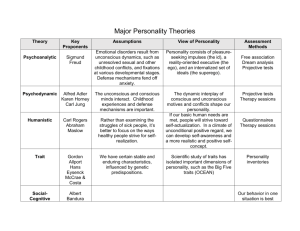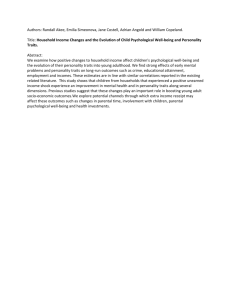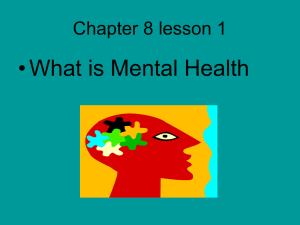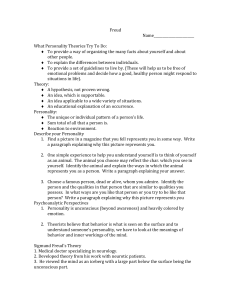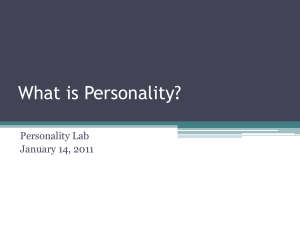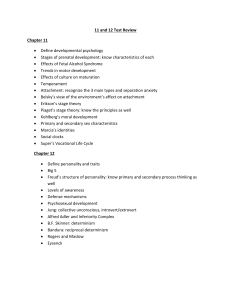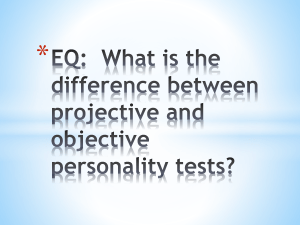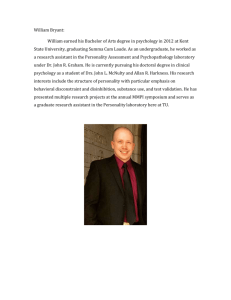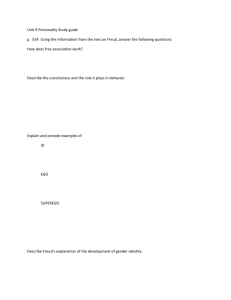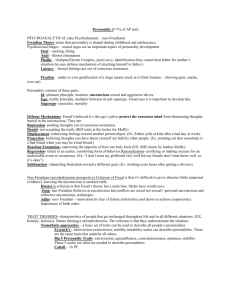Terms Definitions
advertisement
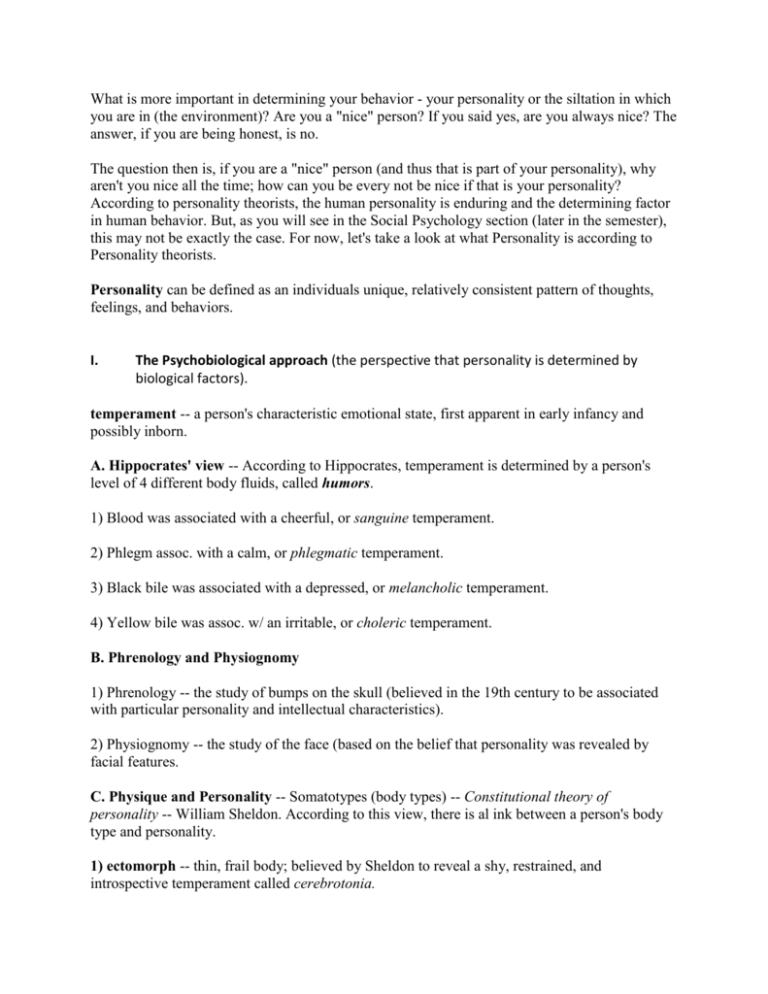
What is more important in determining your behavior - your personality or the siltation in which you are in (the environment)? Are you a "nice" person? If you said yes, are you always nice? The answer, if you are being honest, is no. The question then is, if you are a "nice" person (and thus that is part of your personality), why aren't you nice all the time; how can you be every not be nice if that is your personality? According to personality theorists, the human personality is enduring and the determining factor in human behavior. But, as you will see in the Social Psychology section (later in the semester), this may not be exactly the case. For now, let's take a look at what Personality is according to Personality theorists. Personality can be defined as an individuals unique, relatively consistent pattern of thoughts, feelings, and behaviors. I. The Psychobiological approach (the perspective that personality is determined by biological factors). temperament -- a person's characteristic emotional state, first apparent in early infancy and possibly inborn. A. Hippocrates' view -- According to Hippocrates, temperament is determined by a person's level of 4 different body fluids, called humors. 1) Blood was associated with a cheerful, or sanguine temperament. 2) Phlegm assoc. with a calm, or phlegmatic temperament. 3) Black bile was associated with a depressed, or melancholic temperament. 4) Yellow bile was assoc. w/ an irritable, or choleric temperament. B. Phrenology and Physiognomy 1) Phrenology -- the study of bumps on the skull (believed in the 19th century to be associated with particular personality and intellectual characteristics). 2) Physiognomy -- the study of the face (based on the belief that personality was revealed by facial features. C. Physique and Personality -- Somatotypes (body types) -- Constitutional theory of personality -- William Sheldon. According to this view, there is al ink between a person's body type and personality. 1) ectomorph -- thin, frail body; believed by Sheldon to reveal a shy, restrained, and introspective temperament called cerebrotonia. 2) mesomorph -- muscular, strong body; believed to display a bold, assertive, and energetic temperament called somatotonia. 3) endomorph -- large, soft body; believed to display a relaxed, sociable and easygoing temperament called viscerotonia. D. Heredity and Personality Behavioral Genetics -- the study of the relationship between heredity and behavior. 1) support for this perspective is demonstrated by the differences found in infants. At that early age, personality theorists say that the baby has not had time to learn how to behave, but is behaving according to their innate personalities. 2) Bouchard studies of identical twins reared apart. These studies demonstrate that identical twins who grow up in different homes often exhibit many similar behaviors and characteristics. II. The Psychoanalytic Approach (rooted in the psychobiological approach) - this theory is extremely popular, and was developed by Freud. A. Psychosexual Theory of the Structure of Personality 1) Id (Latin for "it") -- contains innate biological drives, seeks immediate gratification, and operates by the pleasure principle (seeking gratification of impulses). 2) Ego (Latin for "I") -- helps the individual adapt to external reality by making compromises between the id, the superego, and the environment. Operates by the "reality principle" -- directs the individual to express sexual and aggressive impulses in socially acceptable ways. 3) Superego (Latin for "over the I") -- acts as our moral guide; contains the conscience, which makes us feel guilty for doing or thinking something wrong; also contains the ego ideal, which makes us feel good for wanting or doing something good. 4) Defense Mechanisms -- distort reality to protect the ego from anxiety caused by id impulses. There are many different types of defense mechanisms: a) repression -- this is the most often used and central main defense mechanism; it is common to all the others. Repression can be defined as the banishment of threatening thoughts, feelings, and memories into the unconscious mind. b) denial -- refusal to admit a particular aspect of reality. c) regression -- individual displays immature behaviors that have relieved anxiety in the past d) rationalization -- providing socially acceptable reasons for our inappropriate behavior e) intellectualization -- reducing anxiety by reacting to emotional situations in a detached, unemotional way. f) projection -- attributing our undesirable feelings to others. g) displacement -- expressing feelings toward something or someone besides the target person, because they are perceived as less threatening. h) reaction formation -- acting in a manner opposite our true feelings. i) compensation -- reacting to a personal deficiency by developing another talent. j) sublimation -- expression of sexual or aggressive impulses through indirect, socially acceptable ones. B. Analytic Psychology -- Carl Jung Unlike the Psychosexual approach, the analytic approach de-emphasizes the sex motive 1) Personal Unconscious -- the individuals own unconscious mind. 2) Collective Unconscious -- the unconscious mind that is shared by all human beings and that contains archetypal images passed down from our prehistoric ancestors. 3) Archetypes -- inherited images which are passed down from our prehistoric ancestors and reveal themselves as universal symbols in art, dreams, and religion. 4) Extrovert -- a person who tend to focus on the external world and people. People often associate being socially outgoing with extroversion, but that is a little too simplistic. Extroverts may be more outgoing in that they gain energy from the other people and the external environment, and usually prefer to be with others. 5) Introvert -- a person who is focused on (often preoccupied) with his or her private mental experiences, feelings, and thoughts. III. The Dispositional Approach A. Type Theories (Eysenck) 1. Unstable/Stable 2. Introverted/ Extroverted B. Trait Theories -- (Allport, Cattell) -- a trait is a relatively enduring, cross-situationally consistent personality characteristic that is inferred from a person’s behavior. 1) Allport -- created a measure to identify each person’s ‘central traits’; indicated that there is a hierarchy of 3 basic trait types: a) cardinal (similar to types) - this is the big one. Cardinal traits are dominant traits that characterize most of (or almost all) of a person's behavior. Cardinal traits completely dominate a person's sense of self. For example, Charles Manson's evilness could be identified as a cardinal trait or Mother Teresa's altruism. It is important to note that cardinal traits are not common. Most people do not have these traits...people with cardinal traits are considered rare. b) central (humorous, kind) - these traits are central, prominent traits that everyone has (unlike cardinal traits). Our personalities are built upon the central traits. They are influential, but don't dominate like the cardinal traits. c) secondary (food preferences, etc.) - these are traits that are only exhibited in some situations. For example, someone may be kind most of the time, but become very selfish in other situations. 2) Raymond Cattell- factor analysis; 16PF (personality factor) 16 basic traits in all people in varying degrees 3) Hans Eyesenck- believed could classify all people along introversion-extraversion scale and a stable-unstable scale 4) Trait theorists believe we can describe people’s personalities by specifying their main characteristics or traits. a) Nomothetic approach. Theorists that believe that the same basic set of traits can be used to describe all people’s personalities b) Idiographic theorists- argue that each person should be seen in terms of the few traits that best characterize their uniqueness c) A number of contemporary trait theorists believe that personality can be described using the big five personality traits- extraversion, agreeableness, conscientiousness, openness to experience emotional stability d) The number of traits is derived from factor analysis- a statistical technique that allows researchers to use correlations between traits. C. Dispositional Assessment of Personality 1) Personality Types -- Myers-Briggs Type Indicator 2) Personality Traits -- MMPI, CPI IV. The Behavioral Approach - this approach rejects the importance of biological factors in favor of the environmental forces. Instead of traits, behavioral approach proponents believe that behavior is a function of environmental factors and learning. A. Operant Conditioning Theory -since operant conditioning was already discussed in an earlier section, we won't go into much detail. B.F. Skinner was a major proponent of this perspective and believed that what most people referred to as personality was simply a person's distinct behavior pattern that emerged in specific situations. For example, you may think that your teacher is very timid and a straight arrow because you see them only in a very specific situation (the classroom or in the school setting). However, your teacher may behave very differently in another situation that contradicts your perception of their "personality". B. Social Cognitive Theory (Albert Bandura) -- this perspective is quite similar to the behavioral perspective, but here cognitive factors are also considered important in determining behavior (remember that cognitive factors are ignored in strict behavioral theory). So, according to the Social Cognitive Perspective, the environment/learning and cognition are the determining factors in behavior. In addition, there are two important concepts you need to be familiar with: 1) reciprocal determinism -- Bandura’s belief that personality traits, environmental factors, and overt behavior don't determine behavior in isolation. Rather, these factors affect each other to determine our behaviors. Reciprocal determinism also relies on a person's self-efficacy. 2) self - efficacy -- a person’s belief that he or she can perform behaviors that are necessary to produce a desired outcome. Self-efficacy influences what choices we make in different situations, the situations we enter, and the outcomes. For example, do you think a person with low self-efficacy would enter a situation in which they must perform a difficult task in front of a large crowd of people? C. Behavioral Assessment - to measure a person's personality, there are several tools Psychologists with a behavioral perspective may use: 1) Behavioral observation 2) Experience sampling 3) Situational interview 4) Behavioral checklists 5) Cognitive-Behavioral Assessment (Rotter’s Internal/External Locus of Control Scale) V. The Cognitive Approach A. Personal Construct Theory (George Kelly) -- Human beings are lay scientists who continually test hypotheses about social reality (these hypotheses are personal constructs). 1) constructive alternativism -- the ability to apply different personal constructs to a given situation. B. Cognitive Assessment -- Role Construct Repertory Test (Kelly) -- three persons; how are the first two similar and different from the third? How many constructs does the individual use to distinguish between people? Are they too inflexible or flexible (stereotypes vs. ability to predict behavior). VI. The Humanistic Approach A. Self-Actualization Theory (Maslow’s Hierarchy of Needs) B. Self Theory -- incongruence between the self and personal experience. Healthy people have congruence between the self and the ideal self. C. Humanistic Assessment -1) Personal Orientation Inventory -- measures the degree to which a person’s values and attitudes agree with those of Maslow’s description of self-actualized p TermsDefinitions Personality Free association Psychoanalysis Unconscious Id An individual's characteristic pattern of thinking, feeling, and acting. In psychoanalysis, a method of exploring the unconscious in which the person relaxes and says whatever comes to mind, no matter how trivial or embarrassing. Freud's theory of personality and therapeutic technique that attributes thoughts and actions to unconscious motives and conflicts. Freud believed the patient's free associations, resistances, dreams, and transferences—and the therapist's interpretations of them—released previously repressed feelings, allowing the patient to gain self-insight. According to Freud, a reservoir of mostly unacceptable thoughts, wishes, feelings, and memories. According to contemporary psychologists, information processing of which we are unaware. Contains a reservoir of unconscious psychic energy that, according to Freud, strives to satisfy basic sexual and aggressive drives. Operates on the pleasure principle, demanding immediate gratification. Ego Superego Psychosexual stages Oedipus complex Identification Fixation Defense mechanisms Repression Regression Reaction formation Projection Rationalization Displacement The largely conscious, "executive" part of personality that, according to Freud, mediates among the demands of the id, superego, and reality. The ego operates on the reality principle, satisfying the id's desires in ways that will realistically bring pleasure rather than pain The part of personality that, according to Freud, represents internalized ideals and provides standards for judgment (the conscience) and for future aspirations. The childhood stages of development (oral, anal, phallic, latency, genital) during which, according to Freud, the id's pleasure-seeking energies focus on distinct erogenous zones. According to Freud, a boy's sexual desires toward his mother and feelings of jealousy and hatred for the rival father. The process by which, according to Freud, children incorporate their parents' values into their developing superegos. according to Freud, a lingering focus of pleasure-seeking energies at an earlier psychosexual stage, in which conflicts were unresolved in psychoanalytic theory, the ego's protective methods of reducing anxiety by unconsciously distorting reality in psychoanalytic theory, the basic defense mechanism that banishes from consciousness anxiety-arousing thoughts, feelings, and memories psychoanalytic defense mechanism in which an individual faced with anxiety retreats to a more infantile psychosexual stage, where some psychic energy remains fixated Psychoanalytic defense mechanism by which the ego unconsciously switches unacceptable impulses into their opposites. psychoanalytic defense mechanism by which people disguise their own threatening impulses by attributing them to others Defense mechanism that offers self-justifying explanations in place of the real, more threatening, unconscious reasons for ones actions. psychoanalytic defense mechanism that shifts sexual or aggressive impulses toward a more acceptable or less threatening object or person, as when redirecting anger toward a safer outlet Collective unconscious Carl Jung's concept of a shared, inherited reservoir of memory traces from our species' history Projective test a personality test, such as the Rorschach or TAT, that provides ambiguous stimuli designed to trigger projection of one's inner dynamics Thematic Apperception test TAT a projective test in which people express their inner feelings and interests through the stories they make up about ambiguous scenes Rorschach inkblot test the most widely used projective test, a set of 10 inkblots, designed by Hermann Rorschach; seeks to identify people's inner feelings by analyzing their interpretations of the blots Terror-management theory Proposes that faith in one's worldview and the pursuit of self-esteem provide protection against a deeply rooted fear of death. Self actualization according to Maslow, the ultimate psychological need that arises after basic physical and psychological needs are met and self-esteem is achieved; the motivation to fulfill one's potential. Unconditional positive regard according to Rogers, an attitude of total acceptance toward another person Self-concept All our thoughts and feelings about ourselves, in answer to the question "who am I?" Trait a characteristic pattern of behavior or a disposition to feel and act, as assessed by self-report inventories and peer reports Personality inventory A questionnaire on which people respond to items designed to gauge a wide range of feelings and behaviors; used to assess selected personality traits. MMPI The most widely researched and clinically used of all personality tests - originally designed to identify emotional disorders Empirically derived test A test developed by testing a pool of items and then selecting those that discriminate between groups. Social-cognitive perspective Views behavior as influenced by the interaction between persons and their social context. Reciprocal determinism The interacting influences between personality and environmental factors. Personal control Our sense of controlling our environment rather than feeling helpless. External locus of control The perception that chance or outside forces beyond our personal control determine our fate. Internal locus of control The belief that an individual has more control over life circumstances than the environment does. Learned helplessness Lack of motivation to avoid unpleasant stimuli after one has failed before to escape similar stimuli Positive psychology A psychology concerned not only with weakness and damage but also with strength and virtue. Spotlight effect overestimating others' noticing and evaluating our appearance, performance, and blunders. Self-esteem One's feelings of high or low self-worth Self-serving bias A readiness to perceive oneself favorably. Personality is the unique attitudes, behaviors, and emotions that characterize a person.
